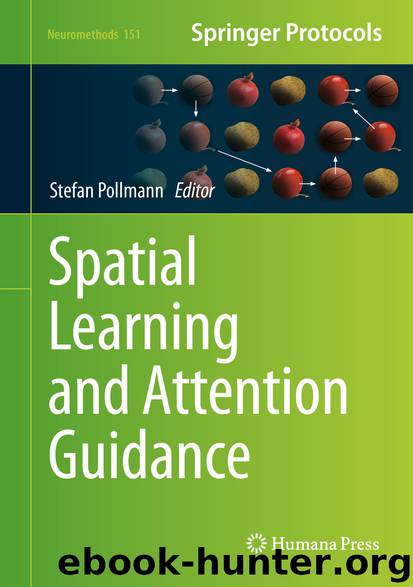Spatial Learning and Attention Guidance by Unknown

Author:Unknown
Language: eng
Format: epub
ISBN: 9781493999484
Publisher: Springer US
3 Theoretical Framework: Solving Correspondence in the Temporal Domain
In his seminal paper, Pylyshyn [17] tested the idea of a rotating attentional spotlight, updating all relevant locations of the objects in succession. Assuming the spatial displacement of a particular object is small enough throughout maintenance intervals, the correspondence between two nearby locations could be bridged, and the perception of object permanence should prevail (Fig. 2a). However Pylyshyn concluded that for his experiments, the average duration of the attentional shift [18, 19] would afford spatial displacements at or beyond the order of inter-item distances and therefore create confusions between relevant and irrelevant items and thus lead to even poorer-than-expected tracking performance [7, 20, 21]. Although the attentional spotlight is able to accomplish smooth pursuits of fast single moving objects, a setup with multiple items requires discrete shifts of the focus between the objects, involving multiple engaging and disengaging processes, which last some hundred milliseconds [22, 23], and are therefore definitively too long to resolve of the correspondence problem during multiple object tracking. However, the idea of a serial tracking process, cycling through the relevant items, has also been revisited [24, 25] under the assumption of constant switching times between items irrespective of their spatial proximity. More target items or higher tracking speed would however increase the temporal proximity of sampling intervals, resulting in a poorer tracking performance (Fig. 2a).
Fig. 2Sources of tracking errors. (a) Solving tracking in the temporal domain: Theoretical frameworks incorporating a single attentional spotlight in solving the correspondence problem during tracking require a higher temporal resolution in more demanding settings. Equal sampling rates of item maintenance result in more frequent inter-item confusions for more relevant (second row) or faster items (third row). Eventually, the distance travelled of one item during a sampling cycle exceeds inter-item proximities, resulting in swapping of target locations. (b) Solving tracking in the spatial domain: A higher spatial resolution is required for the multifocal approach whenever the number of relevant items (second row) or the item speed (third row) increases in order to resolve smaller inter-item proximities. (c) Configuration tracking: The maintenance of the relevant targets as a singular configurational representation is disrupted primarily by collapse of its convex hull. Events of collapse occur whenever a single item crosses the imaginary edge of the entire hull
Download
This site does not store any files on its server. We only index and link to content provided by other sites. Please contact the content providers to delete copyright contents if any and email us, we'll remove relevant links or contents immediately.
Cecilia; Or, Memoirs of an Heiress — Volume 3 by Fanny Burney(31424)
Cecilia; Or, Memoirs of an Heiress — Volume 2 by Fanny Burney(31369)
Fanny Burney by Claire Harman(26209)
We're Going to Need More Wine by Gabrielle Union(18582)
Plagued by Fire by Paul Hendrickson(17070)
Cat's cradle by Kurt Vonnegut(14692)
All the Missing Girls by Megan Miranda(14518)
Bombshells: Glamour Girls of a Lifetime by Sullivan Steve(13655)
Leonardo da Vinci by Walter Isaacson(12737)
4 3 2 1: A Novel by Paul Auster(11739)
For the Love of Europe by Rick Steves(11248)
Adultolescence by Gabbie Hanna(8563)
The remains of the day by Kazuo Ishiguro(8338)
Note to Self by Connor Franta(7428)
Diary of a Player by Brad Paisley(7229)
Giovanni's Room by James Baldwin(6743)
What Does This Button Do? by Bruce Dickinson(5914)
Born a Crime by Trevor Noah(5043)
The Kite Runner by Khaled Hosseini(4918)
